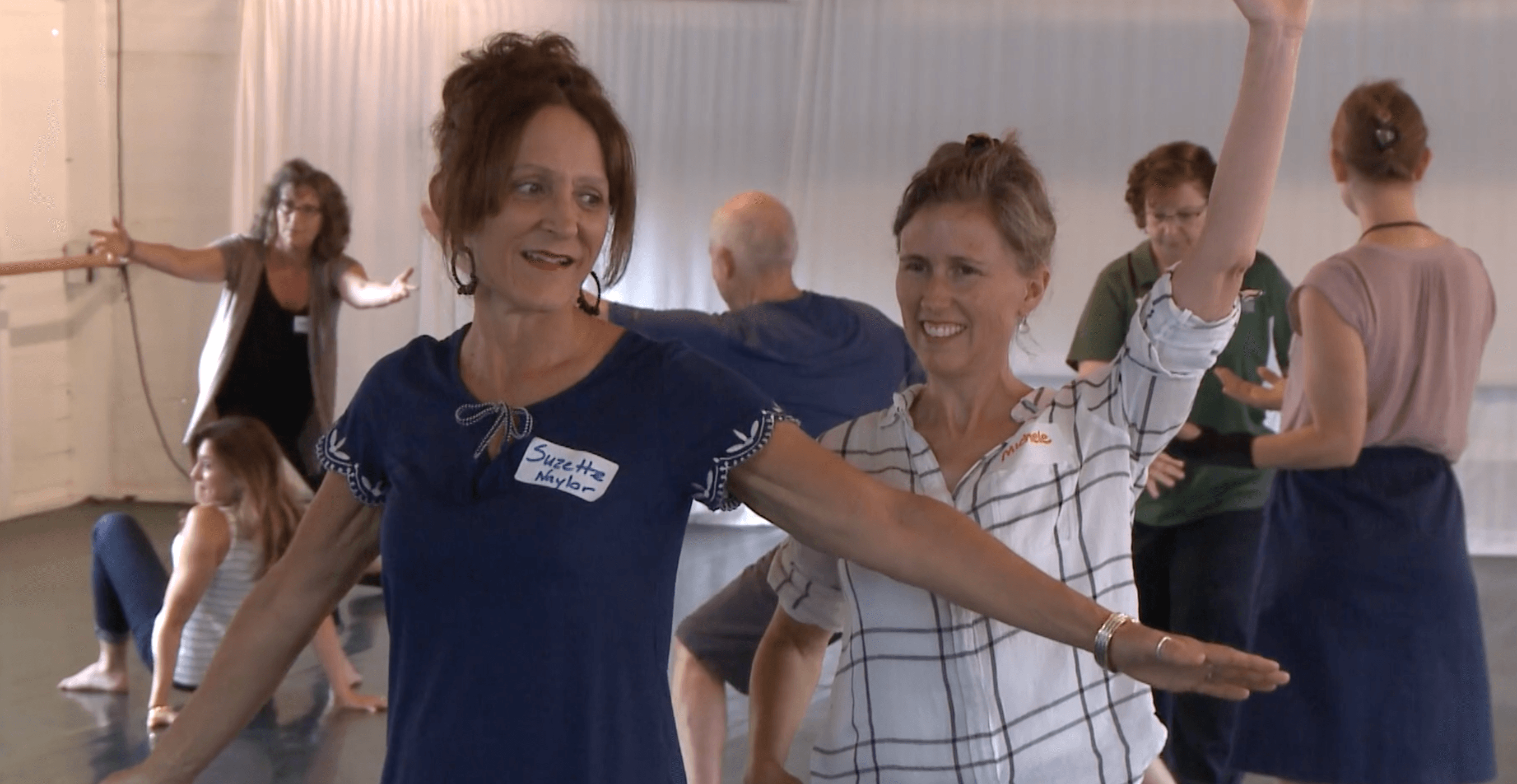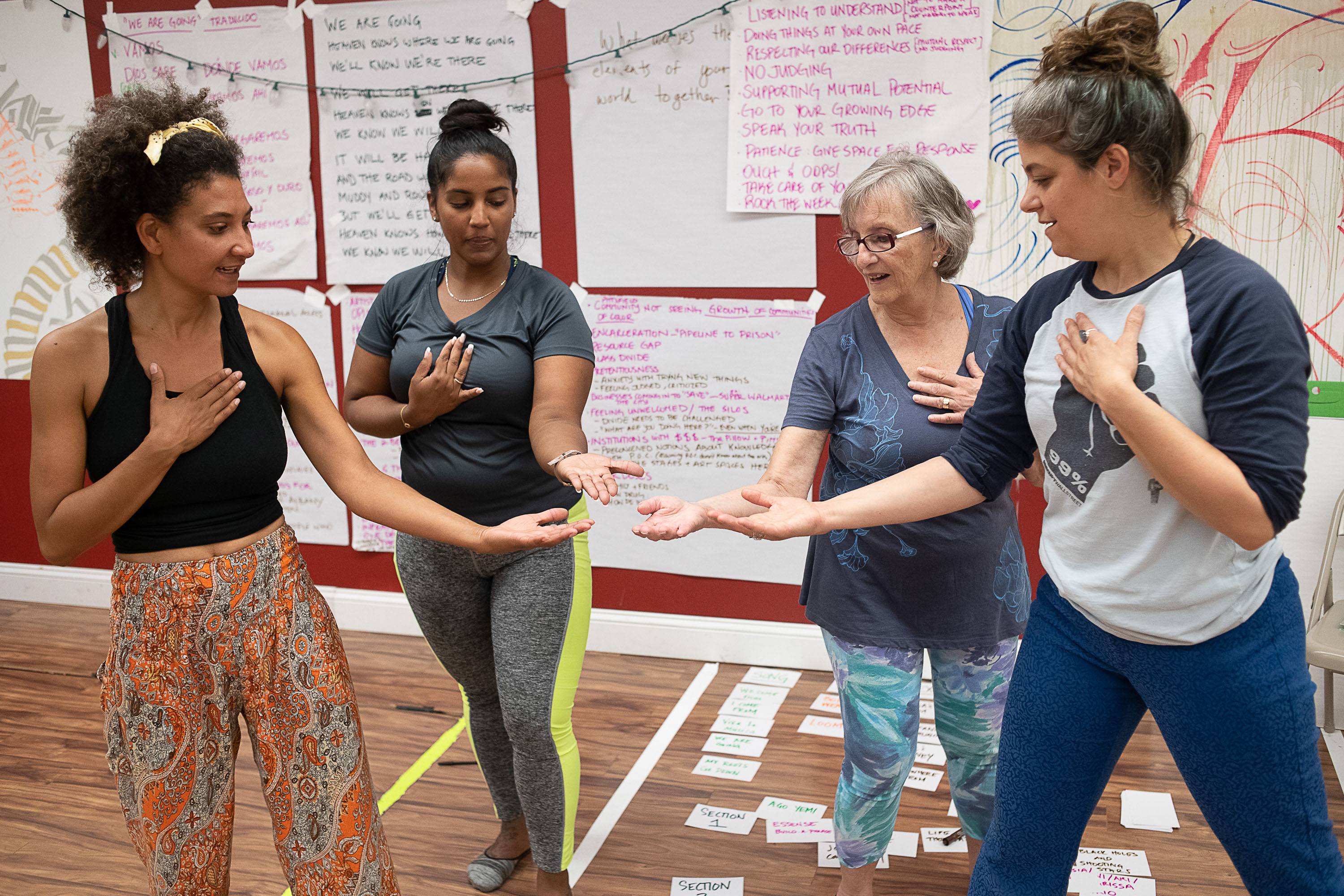
During Festival 2018 Jacob’s Pillow welcomed Berkshire County medical practitioners and administrators for the launch of a pilot program called Medicine in Motion. Through a Creativity Connects grant, awarded by the National Endowment for the Arts, and in partnership with Berkshire Health Systems and Volunteers in Medicine, this program offers a series of workshops and symposia to research how dance and the Jacob’s Pillow Curriculum in Motion® approach can improve the health and morale of medical employees, nurture creative problem-solving, and promote well-being. Partners participated in a workshop led by JPCiM® co-founder Celeste Miller, attended a matinee performance by Houston Ballet, and participated in a facilitated discussion linking dance and their experience to well-being. Learn more about Celeste Miller’s work in Medical Humanities.
Pillow Intern Rachel Chozick sat down with Celeste Miller to discuss this exciting new program at the Pillow.
What is Medicine in Motion?
Medicine in Motion is a natural organic development of a program called Jacob’s Pillow Curriculum in Motion® which has been around for 25 years and focuses on partnering with K-12 classrooms. I was a co-founder of JPCiM® and it led me to wonder what would happen if we built out this idea of immersion in dance-based practice for creative expression, reflection, rejuvenation, and to soothe, fuel, and replenish our humanness. This kind of immersion in arts-based experiences contributes to our flourishing of the human experience. Immersion takes many forms including seeing a performance, spending time in the Archives, and participating in a workshop.
My work is about finding how the heart and soul of what dance is can be shared with people beyond the sphere of those who have made dance their profession. People hear the word dance and put it in a small box, a box of “I can’t do it.” My life’s goal has been to open up the box and turn it into a basket where everyone can engage.
Narrowing it down to think about Medicine in Motion; I started working with medical practitioners about 25 years ago. I asked myself, “What are the ways we can use dance to engage with medical practitioners as they reflect on their practice of medicine?” There are many programs in place that use dance and art to help patients. Medicine in Motion uses improvisational dance technique to provide a space for self-reflection for medical providers; which then provides a clarity of purpose to the providers that then gets transferred to their work with their patients.
Can you explain why leaders in the local medical field came for a Day at the Pillow visit?
On August 16, 2018, we hosted a Day at the Pillow with stakeholders of the partnerships we’re trying to build for Medicine in Motion. The idea was to connect with leaders who have people who are delivering healthcare into the community. It’s a model that spreads wide. If we work with ten leaders and each of them works with 400 healthcare providers, we’re impacting 4,000 people.
Suzette Nayor, Coordinator of Surgical Residencies for Berkshire Health Systems, works with surgical interns. During the Day at the Pillow visit, we began brainstorming the ways she could help us organize a workshop for these surgical interns.
“We need to enhance our resilience so that will influence how we help those we work with.”
Dr. Mark Pettus
How will this project unfold?
We’re envisioning a two-pronged program. The focus of the Day at the Pillow visit was to engage deeply in dance as a resource and as something you could view and participate in. Part two will be going to various locations within Berkshire Health Systems to lead workshops.
The Day at the Pillow included a workshop lead by an artist facilitator around a content topic—using dance as an embodied learning tool to impact an idea. At this workshop, we studied what it means to flourish as a human. There’s been some really interesting research around the components. Connect, active, keep learning, notice, and give. Now to apply them directly to dance:
- In an interactive workshop, of course, you’re connecting with others.
- There are other ways to be active, besides physically moving. When someone engages with the aesthetic of an art form and finds their own creative expression, their brains are active.
- Notice the power of nonverbal communication, simple touch, and taking movement cues from another person to build your own response and exchange.
- Keep learning. When they first came into the workshop the majority had no dance experience, but within ten minutes they were given a handful of tools they could engage with and practice with. They learned and kept expanding their knowledge.
- I’m sharing knowledge and tools, but they’re giving back with their “yes” attitudes, questions, and support.
After the workshop the group shared a communal meal, took a tour of the Pillow and attended a performance of the Houston Ballet, viewing the performance through the lens of: connecting, being active, noticing, learning, and how a performance is a give and take with the audience.
What about your background inspired you to start this program?
I’ve been a dancer and choreographer my entire professional life. I was 16 in 1969 and I was trying to figure out if I should be in the dance studio or in the streets. I asked questions like “What is the purpose of dance?” and “What is the purpose of me as a human on the face of the earth?”
“In those turbulent times, I wanted to make art that mattered and understand what makes meaning in the world.”
I wasn’t a social worker or a community organizer. I just wanted to keep dancing so I started searching for people who had begun to ask these question too.
Alwin Nikolais and Murray Louis began at the Henry Street Settlement in NYC where in the community you could provide a wealth of services for people: health, education, and arts, and not separate from one another. As developing artists, engagement with the community in this way was essential to the way we make and share art.
I work as a choreographer for professional dancers and I also love working with people who don’t consider themselves dancers. I love teaching in systems where the population wouldn’t have previously used these tools within their lives or work.
What’s next for Medicine in Motion?
There will be a series of two-week residencies where two to three JPCiM® artists educators will be paired up with the groups that our stakeholder circle has identified. There will be several Day at the Pillow visits over the course of the summer.
COMMUNITY PROGRAMS & EVENTS
Pillow artists and staff develop programs that connect participants to the physical, emotional, intellectual, and inspirational world of dance.
COMMUNITY PROGRAMS & EVENTS
Pillow artists and staff develop programs that connect participants to the physical, emotional, intellectual, and inspirational world of dance.
